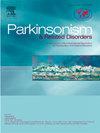早发性帕金森病:鉴别诊断和不容错过之处。
IF 3.1
3区 医学
Q2 CLINICAL NEUROLOGY
引用次数: 0
摘要
早发性帕金森病(EOP)是指在 50 岁之前发生的帕金森病。发病原因多种多样,包括继发性和遗传性原因。与药物、炎症和感染性疾病有关的继发性病因大多可以治疗,并且很容易被识别,因为与特发性帕金森病相比,它们的临床病程通常相对更快。遗传性帕金森病的诊断更具挑战性,尤其是因为更多的非帕金森病基因被认为可表现为典型和非典型帕金森病。一些遗传性疾病,如脊髓小脑共济失调 2(SCA2)和脊髓小脑共济失调 3(SCA3),可能表现为左旋多巴反应性帕金森病,与特发性帕金森病无异。此外,一些遗传性疾病,包括威尔逊氏病和脑黄瘤病 (CTX),可能是可以治疗的,不应错过。由于新一代测序技术的出现,基因分析有助于早期识别和正确治疗引起 EOP 的各种病因。在这篇综述中,我们概述了 EOP 的临床方法,强调了一些非 PARK 遗传性 EOP 病因的主要临床特征和相关检查,这有助于临床诊断。本综述还包括基因诊断方法,强调检测前咨询的重要性和生物信息学分析策略的原则。本文章由计算机程序翻译,如有差异,请以英文原文为准。
Early Onset Parkinsonism: Differential diagnosis and what not to miss
Early Onset Parkinsonism (EOP) refers to parkinsonism occurring before the age of 50 years. The causes are diverse and include secondary and genetic causes. Secondary causes related to medications, inflammatory and infective disorders are mostly treatable and well recognized as they usually present with a relatively more rapid clinical course compared to idiopathic Parkinson's disease. Genetic causes of EOP are more challenging to diagnose especially as more of the non-PARK genes are recognized to present with typical and atypical parkinsonism. Some of the genetic disorders such as Spinocerebellar ataxia 2 (SCA2) and Spinocerebellar ataxia 3 (SCA3) may present with levodopa-responsive parkinsonism, indistinguishable from idiopathic Parkinson's disease. Additionally, some of the genetic disorders, including Wilson's disease and cerebrotendinous xanthomatosis (CTX), are potentially treatable and should not be missed. Due to the advent of next generating sequencing techniques, genetic analyses facilitate early identification and proper treatment of diverse causes of EOP. In this review, we outline the clinical approach of EOP highlighting the key clinical features of some of the non-PARK genetic causes of EOP and related investigations, which could assist in clinical diagnosis. This review also encompass genetic diagnostic approaches, emphasizing the significance of pretest counseling and the principles of bioinformatics analysis strategies.
求助全文
通过发布文献求助,成功后即可免费获取论文全文。
去求助
来源期刊

Parkinsonism & related disorders
医学-临床神经学
CiteScore
6.20
自引率
4.90%
发文量
292
审稿时长
39 days
期刊介绍:
Parkinsonism & Related Disorders publishes the results of basic and clinical research contributing to the understanding, diagnosis and treatment of all neurodegenerative syndromes in which Parkinsonism, Essential Tremor or related movement disorders may be a feature. Regular features will include: Review Articles, Point of View articles, Full-length Articles, Short Communications, Case Reports and Letter to the Editor.
 求助内容:
求助内容: 应助结果提醒方式:
应助结果提醒方式:


